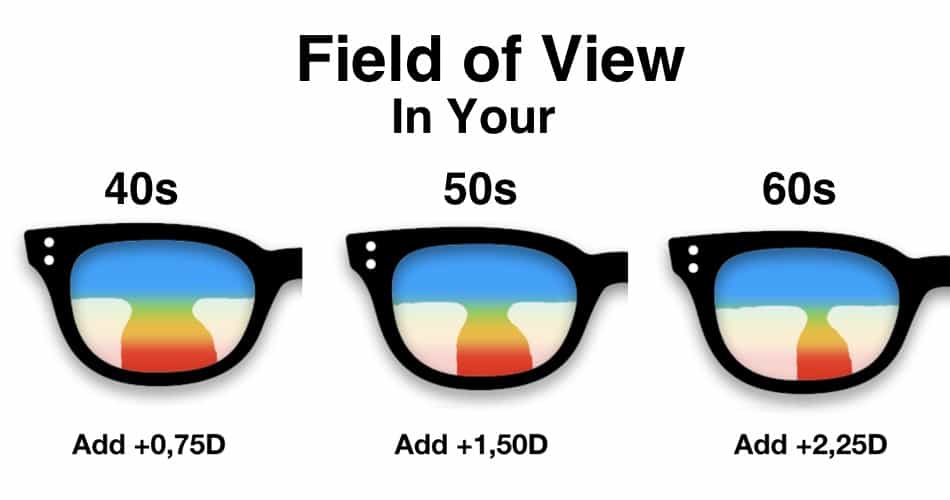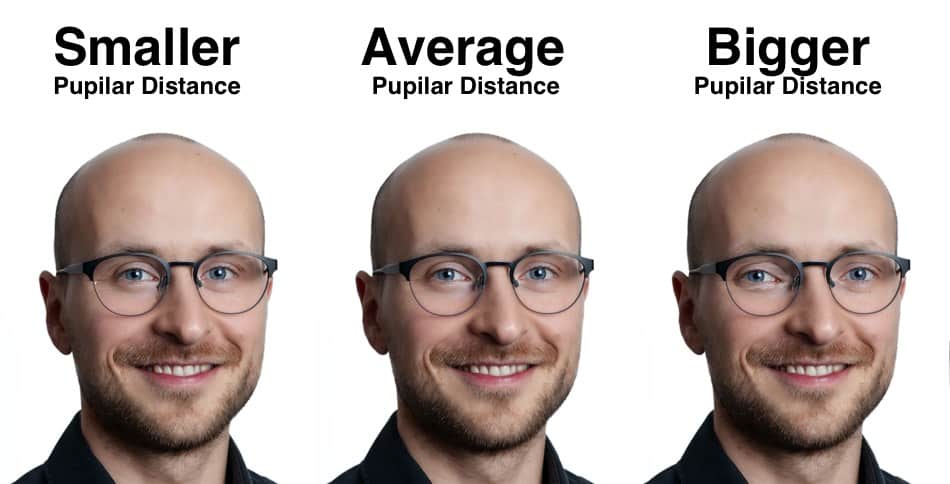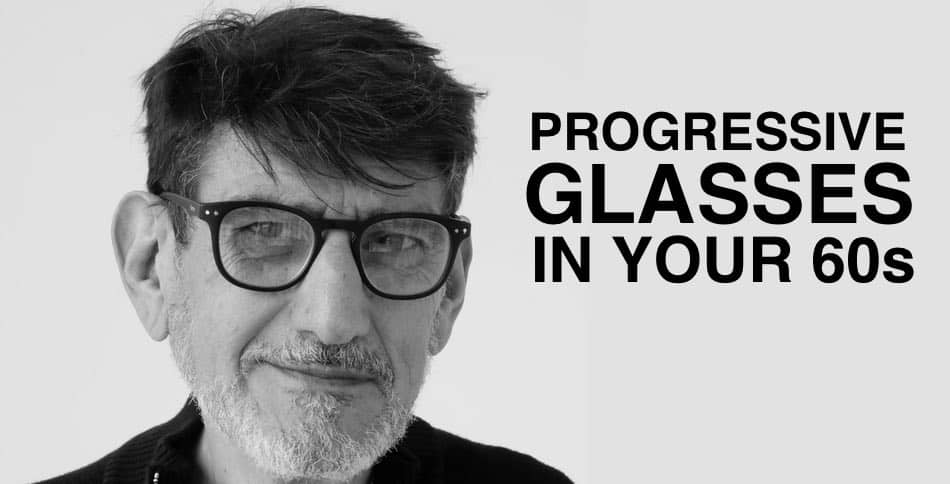The cost of progressive lenses varies a lot. Depending on what you need your glasses can cost only 99$ up to over 1000$. The lenses have different features and we will go into detail to give you a better understanding of what your price will be.
| Janet 40 years old | Jonathan 55 years old | Harald 65 years old | |
| PD optimized Progressives | ✓ | ✓ | |
| Vertex distance considered | ✓ | ✓ | |
| Thinner materials | ✓ | ✓ | |
| Basic AR, hard- and clean coat | ✓ | ✓ | |
| Premium AR, super hard and a better clean coat | ✓ | ||
| Transitions | ✓ | ||
| Pantoscopic tilt is considered | ✓ | ✓ | |
| Prisms | |||
| Premium manufacturer | ✓ | ||
| Lesser-known manufacturer | ✓ | ✓ | |
| No name frame | ✓ | ||
| Designer frame | ✓ | ✓ | |
| Total cost for progressives glasses | 450$ | 760$ | 1400$ |
Now you saw an overview of the different possibilities let us dive deeper into consultation to see who needs what and why. Just a side note before we move on. Nearly every prescription for most people is technically producible. So you can get a low-cost pair of progressive lenses even if it is not recommended in this article. The drawbacks will be a smaller field of view and less comfort in vision. Prices may vary in your country.

The Cost of Progressive Lenses in Your 40s
In the second column of the table above, Janet is our first example and she just starts to see some changes in vision. On a good day she can just read all she wants but when the lighting is less perfect reading feels tiring. She goes to her eye care specialist and everything gets measured. And this is her results:
| SPH | CYL | A | ADD | |
| R | 0,50 | 1,00 | ||
| L | 0,50 | 1,00 |
Her vision felt really good with the testing frame and she does not want two pairs of glasses so she decides to take progressive glasses. Her face has standard dimensions. It sounds a little strange to categorize people’s faces that way but we are talking about the width of the pupilar distance. And this is a very important parameter in progressive lenses that will change the costs if it has to be adjusted.
As you look at her prescription her lens power is pretty low. In combination with the low lens power (0,50D) comes the reading power which is also just 1,00D. That tells us she will experience a very wide field of view in her progressive lenses. The lower the power is in the lenses the less distortion can be experienced. To her, it would not make a difference to built-in all the optimization because there is nothing to optimize.

She just falls into the standard set of parameters. If that happens, of course, she will be fine with lower-priced lenses. She can now decide if she wants to go with a premium brand to get increased UV protection due to special coatings, harder surfaces, and a better clean coat.
She decides to stay with the lesser-known manufacturer because the optician told her that she will need a stronger pair of lenses as she ages. If she had chosen a premium brand her price would be higher, probably around 650$. Could she have also ordered a pair of absolute high-end progressive glasses for 1400$? Yes of course. Would it make any difference to her? Not at all.
The Cost of Progressive Lenses in Your 50s
| SPH | CYL | A | ADD | |
| R | -3,0 | -1,0 | 0° | 1,75 |
| L | -3,0 | -1,0 | 0° | 1,75 |
Our second example is Jonathan with a little higher lens power. His progressive lenses also need to hold a reading zone. In this case, his ADD is 1,75D. He can not actually read anymore with normal single vision glasses made just for the distance.
As the reading zones getting stronger Jonathan will experience a smaller space in the middle distance and reading zone for eye movements. He actually needs to compensate for this a little bit by pointing his nose more in the direction in which he wants to look at something compared to Janet. When this happens a better lens design should be chosen to make up for the smaller getting reading space.
Jonathan understood that a really good positioned sharp space (even if it is little) right before his eyes will give him wider fields of view and more comfort in vision in his day to day tasks. He saw realistic pictures of the lenses and the middle distance part looked small. He wanted to get these parts as positioned as perfect in front of his eyes to get the biggest fields of view possible.
With an Add value close to +2,00D progressive lenses will hold more peripheral distortions and blurriness in the sides as you read. Getting the widest field of view still means your eye movements will be restricted. I just want to point this out a little bit more to sidestep a misconception of a first-time buyer of progressives.
The best position of the reading space will be achieved through individual changes in Jonathan´s lenses. These options are check-marked in the upper part of the table like PD optimization and the vertex distance.

People with a bigger pupilar distance (PD) will benefit from this feature because it considers that people with a really wide PD perform will use other spots and move their eyes slightly from another angle as someone with a small PD would do. In combination with the knowledge of how far the lenses sit in front of his eyes (vertex distance) and in which distance he reads, he can get extremely wide fields of view.
As you look at someone’s glasses from the side, you will notice a tilt. The lenses are a little bit tilted and the amount of tilt can also change the width of the reading zones. If it can not be changed (with a smaller or bigger pantoscopic tilt) it is good to consider this feature if the lens’s tilt diverges from 8°. Because the frame can not be adjusted to the perfect position of a standard lens, the lens has to be changed in the angles and distances as worn in reality.
In this case, he wanted to get the biggest bang for the buck. So this is what the optician came up with. An individual progressive lens from a lesser-known manufacturer. It is also thinner due to the choice of materials. Jonathan cares about his lenses a lot so the surface of the lenses is always looking good even after years of usage. He wants a save a little but still want a decent performance of his progressives.
The surface of the lens will in many cases not be as hard as from a “premium brand”. As we saw thousands of customers with different qualities of progressives. The coatings from the lower-priced manufacturers usually look more worn due to the rubbing over the years that produces tiny scratches on the surface of your lenses. On average you will not see it as often with harder coatings from higher-priced brands. However, some customers present you with a perfectly fine surface with lower-priced lenses and some just do not care about the lenses and will abrade the coating in a few months also from a premium brand.
So this is what Jonathan got for a price tag of 760$. Could he also buy progressives that would be a lot more expensive? Yes, of course. Would it make a difference for him? Maybe. Some people are more sensitive to the finetuning the manufacturer makes to give you the best vision possible. At this stage, some people tell they definitely recognize a difference in lower and higher-priced manufacturers and some do not make a difference whatsoever.
The Cost of Progressive Lenses in Your 60s
The third example in the table is Harald. He is dependent on his progressive glasses and he does not want to be restricted if there was a better solution. And here is his prescription:
| SPH | CYL | A | ADD | |
| R | 3,50 | -1,75 | 90° | 2,25 |
| L | 2,00 | -1,00 | 92° | 2,25 |
Harald´s progressive lenses are much stronger in general and regarding the difference from distance to near range vision. That will lead to more distortion in the periphery. When the frame sits in his face in a more or less tilted way he will recognize this a lot sooner as in both examples above. The result of not optimally manufactured progressive glasses would be blurry vision.
He wants to have the best for his eyes. The best vision possible combined with optimal protection. Harald has little yellowish spots on the white space on his eyes and therefore wants the best UV protection possible. He ordered an additional coating to give his eyes even more protection to block UV light. These coatings are usually just available from the premium manufacturers.

If features like these coatings are not as common in the market you need to choose lenses with a higher price tag. The same is true for the other parameters. Here in our example, Harald has a little higher prescription and if this is combined with a larger or smaller PD it just makes sense to get the customized lenses. Even if they cost him a little bit more.
The total cost of his progressive glasses is 1400$. Which is a lot but he does not want to experience any less than the best. Could he also be happy with a pair of progressive glasses that cost him about 400$ and experience the same Vision? It is not so likely but if he falls in the range of all the standard parameters (which is not so common) then this could be true. Most people recognize the difference if the lenses start to have a higher power.
Are More Expensive Progressive Lenses Better?
Not by design. If you need the feature of a PD-optimized progressive lens and it just is not ordered you will not have the benefit even if they can be expensive. In such a case a lower-priced model that is optimized for the PD would be better.
Oftentimes you can get the progressive lens models customized especially with the known manufacturers. But the optician decides if the features are ordered or not. For example, you can get the lens Varilux (progressive lens) E Design (model) from Essilor which is the manufacturer which is a premium lens. Nice, but does premium mean it is being automatically customized for you. No, the f-360 must be ordered to get the customization.
So just ask the optician what you get. In which way does your chosen lens make your vision better than the cheaper model? If he does not know how is he supposed to know what lens to choose and why?
The Costs for Progressive Glasses with Astigmatism
The cost for progressive glasses with astigmatism is nearly the same as without it if it stays in the range of 2D. If your astigmatism is higher you probably will have to pay around 40$ more per lens. Your astigmatism can be ordered in the cheap progressives starting at a cost of 100$ for one lens.
The Costs for Progressive Glasses with Prism
The cost of the prism is approximately an additional 50$ per lens and is available in the cheaper progressives starting at 100$ to higher-end models up to 600$ (for one lens). However, choosing a more customized (better) lens can make a big difference depending on your prism and prescription in general.
More customized lenses can lead to more crisp vision and wider fields compared to the lower-priced standardized progressives. If your lenses in the lower range the differences won’t be as radical but with more prismatic power you will probably have a whole other experience with your progressive glasses.
The Costs for Progressive Glasses with a Wide View
A wide view or a progressive lens with individual parameters start at 250$ for one lens and go up to 600$. The price varies depending on what the manufacturer is chosen and how the lens can be optimized.
Progressive glasses are not produced equal and the term wide view is nothing that tells you which specific lens you get. For example, I give you a lens with a wider view and all I did was to make the corridor longer. That way the transition from distance vision to the reading zone is a bit smoother and the corridor gets a little wider. But it was the same model. Which could be cheap, mid-priced, or have a premium price tag.
If you need to know what the cost is for the wide view lenses you need to ask in a more specific way. What does this lens actually do to make ms view wide? If the following is built in you probably will have a wide view:
- PD optimized
- the reading distance can be considered
- vertex distance
- pantoscopic tilt
As you saw here in the article the costs of progressive lenses/glasses are heavily dependent on the wishes of the wearer and his prescription. In general, my recommendation will go to more costly lenses if your prescription has higher parameters because those progressive can do more for you (if necessary). But that is a very brought statement because most prescriptions can be produced in cheaper lenses too. And if you are happy with it that is all that counts.
I hope I could give you some insides here about the costs of progressive and I just wish you a great day.

